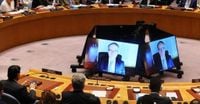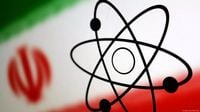For the first time since the eruption of hostilities between Iran and Israel in June 2025, a senior official from the International Atomic Energy Agency (IAEA) arrived in Tehran on August 11, 2025, to hold talks with Iranian authorities. The visit, which comes on the heels of a turbulent period marked by military strikes, diplomatic breakdowns, and mutual recriminations, signals a tentative step toward re-engagement between Iran and the United Nations’ nuclear watchdog. Yet, as both sides have made clear, the road ahead is anything but straightforward.
According to multiple international news outlets, including Caliber.Az and Al Jazeera, the IAEA’s Deputy Director General Massimo Aparo traveled to Tehran for discussions with a high-level Iranian delegation. This group included officials from Iran’s Ministry of Foreign Affairs and advisors from the Atomic Energy Organization of Iran (AEOI). The talks, described by Iran’s Foreign Ministry spokesperson Esmaeil Baghaei as “technical and complicated,” focused on redefining the method and framework of future cooperation between Iran and the agency. No visit to any of Iran’s nuclear sites was on the agenda—an intentional omission that underscores the current impasse.
Foreign Minister Abbas Araghchi, speaking on August 10, emphasized that the negotiations were aimed at “establishing a new framework for cooperation,” one that would be “firmly based on the law passed by the esteemed Iranian Parliament.” He added, “There are no plans for open inspections. We have not yet reached an agreement on the new framework, and cooperation will not begin until such an agreement is in place.” The focus, he said, would be strictly on bilateral cooperation regarding Iran’s peaceful nuclear program.
This diplomatic overture comes after a dramatic and violent summer. In June, Israel launched a series of airstrikes on key Iranian nuclear sites during a 12-day war, with the United States reportedly joining the fray by targeting additional Iranian facilities. The attacks, which killed hundreds of civilians and several high-ranking Iranian military figures and nuclear scientists, left the country’s nuclear infrastructure severely damaged. In retaliation, Iranian strikes killed 28 people in Israel. The conflict, as reported by Al Jazeera and Iran’s state-run media, not only escalated military tensions but also led to a complete suspension of Iran’s cooperation with the IAEA.
On July 3, Iranian President Masoud Pezeshkian signed a law—passed by the Iranian Parliament—that required the government to suspend all cooperation with the IAEA. Under the new law, any future collaboration or inspection by the agency must be approved by Iran’s Supreme National Security Council, a move that significantly curtails the IAEA’s ability to monitor Iran’s nuclear activities. The law was a direct response, Iranian officials say, to what they perceive as the agency’s failure to protect Iran’s interests during the June conflict.
Indeed, Iranian officials have been vocally critical of the IAEA’s conduct throughout the crisis. Deputy Foreign Minister Kazem Gharibabadi, in an interview with the Tehran-based newspaper Iran, said, “The Iranian delegation expressed its strong criticism and protest towards the Agency’s failure to fulfill its responsibilities during the aggression by the Zionist regime and the United States, and informed the Agency’s delegation of our country’s demands for reforming the incorrect processes governing the Agency in relation to the Iranian nuclear issue.” Esmaeil Baghaei, the Foreign Ministry spokesperson, echoed this sentiment, telling reporters, “Peaceful facilities of a country that was under 24-hour monitoring were the target of strikes, and the agency refrained from showing a wise and rational reaction and did not condemn it as it was required.”
From the IAEA’s perspective, the priority is clear: restore access to Iranian nuclear sites and resume inspections. Director General Rafael Grossi has repeatedly stated that resuming inspections is his “top priority.” The agency’s Board of Governors, a 35-nation body, declared Iran in breach of its non-proliferation obligations on May 31, 2025, following the release of a damning report that, according to Tehran, paved the way for the subsequent military strikes. Iran, for its part, has consistently denied seeking nuclear weapons and has reiterated its commitment to the nuclear Non-Proliferation Treaty (NPT), a point repeatedly emphasized in statements to the international press.
Yet, the reality on the ground is that since the June conflict, IAEA inspectors have been denied access to Iranian nuclear facilities. The current talks, as Iranian officials have stressed, are not about immediate site visits but rather about negotiating the terms under which future cooperation might resume. “A Deputy Director General of Grossi will come to Tehran tomorrow, while there are no plans to visit any nuclear sites until we reach a framework,” Araghchi said on his Telegram account, as cited by Caliber.Az.
The stakes are high. Iran’s nuclear program has long been a flashpoint in Middle Eastern and global geopolitics. While U.S. intelligence agencies and the IAEA have assessed that Iran last had an organized nuclear weapons program in 2003, concerns have persisted as Tehran has enriched uranium up to 60 percent—a technical step away from the 90 percent required for weapons-grade material. The new restrictions on IAEA access are likely to further limit the agency’s ability to monitor Iran’s nuclear activities, raising alarm in Western capitals and among non-proliferation advocates.
In the meantime, the talks in Tehran concluded with a decision to continue consultations. Gharibabadi told Iran’s state-run IRNA news agency that Aparo had left Tehran after the meetings, and that both sides agreed to keep the dialogue open. The IAEA, for its part, did not immediately issue a statement on the outcome of the visit. As for the prospect of a breakthrough, Baghaei cautioned, “It is a bit soon to predict what the talks will result since these are technical talks, complicated talks.”
The broader context remains fraught. Iran’s insistence that any future cooperation with the IAEA must be channeled through its Supreme National Security Council is a clear signal of the government’s intent to tightly control the process. At the same time, the country’s leadership continues to frame its nuclear ambitions as strictly peaceful, even as it faces mounting pressure from both the IAEA and Western governments to provide greater transparency.
What comes next is uncertain. The recent talks may have opened a door, but the path to a durable agreement—and to restoring full IAEA oversight—will require overcoming deep mistrust, addressing the fallout from recent violence, and bridging significant political and technical divides. For now, both sides appear to be circling each other warily, aware that the stakes—for Iran, the IAEA, and the world—could hardly be higher.


